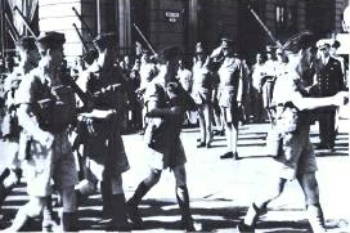| |
A Testament to
Courage
If indeed the men of the
Royal Rifles were so poorly trained as some have said, it is a
testament to their courage that they fought so long, so hard,
and inflicted such devastating damage on the battle-hardened
Japanese Troops. For eighteen long days, they fought some of the
fiercest battles in WWII.
From Newfoundland the Royal Rifles were sent to St. John, New
Brunswick for three weeks. From there they returned to Quebec
City for 48 hours' leave.
Outward Bound
In October of 1941, the Royal
Rifles of Canada said their good-byes to loved ones and friends
on the platform of the Gare du Palais, the railroad station in
Quebec City, and boarded a train for the long journey West to
Vancouver. There
they joined up with the Winnipeg Grenadiers, many of whom were
suffering the effects of dengue fever and malaria picked up
while in the tropics. On October 27, they boarded the Awatea, a
converted cruise ship, and accompanied by the H.M.C.S. Prince
Robert set sail for destinations unknown.
The Awatea carried 90 officers, a Headquarters staff and 2
nursing sisters and 1,877 other ranks. The ship was so
overcrowded that 49 Grenadiers and 1 Rifleman jumped ship in
protest the night before she sailed and had to be
"persuaded" to re-board and make the ill-fated journey. "C"
Company of the Royal Rifles made the trip aboard the Prince
Robert under the command of Major W.A. Bishop.
Rifleman Sydney Skelton was a short, slim 19 year-old man,
married for 10 months, with a baby on the way. He had
volunteered for service in Europe and had served a year in the
army when he found himself on the way to Asia with "D"
Company of the Royal Rifles of Canada. He remembered the first
night aboard the Awatea, "Things began to look pretty bad (the
first night). Supper time came and the lads waited hours for it
and it turned out to be tripe and onions." Even Brigadier W.J.
Home commented about things on board that night, "..things were
in a hopeless muddle.", he said.
Both ships sailed under sealed orders for security reasons.
Their final destination was unknown, even to the ship's captain.
Some of the men put two and two together and guessed that their
destination was somewhere tropical. They had been issued
tropical uniforms, were sailing from Vancouver...they were going
someplace warm. They did not know, or even guess, that it was to
get deadly hot.

The Canadian
Troops Arrive
On November 16th., 1941 the
Canadian troops reached Hong Kong and paraded smartly through
the streets, were greeted by Hong Kong Governor, Sir Mark Young
and the new GOC of British forces in China, Major-General
Christopher M. Maltby. The Canadians arrival brought the total
number of troops available to protect the colony to 15,000.
The Defending
Forces
The men of the Royal Rifles
of Canada and the Winnipeg Grenadiers had no idea they were
shortly to endure the most incredible hardships and dangers of
their lives. They were about to write a chapter in Canadian
Military history that gives truth to the motto of the Royal
Rifles, "Volens et Valens", "Able and Willing".
The British Crown Colony of Hong Kong and The New Territories
consisted of 1060 square kilometers of rugged terrain. The
Island of Hong Kong was jagged. The hills were steep, with deep
canyons, narrow ravines and miles of concrete water catchments
which crisscrossed the island.
Before the Canadians' arrival, the British had 12,000
troops to defend the entire area and they were truly a mixed
assortment. There were at least 16 units from every branch of
the military. Of those about 10,000 were professional soldiers.
The rest were recently activated militia units such as the Royal
Rifles, The Winnipeg Grenadiers and the Hong Kong Volunteer
Defense Force. The famous 2nd Battalion of the Royal Scots,
Britain's Senior Regiment of the Line, and the highly regarded
5/7 Punjabis and the 2/14 Rajputs, had a long and proud history
of service, but even they had lost top officers and NCO's who
had been sent back to England as instructors. They, along with
the 1st. Battalion of the Middlesex (Machine Gun) Regiment,
were meant to be the backbone of the defense.
The Royal Navy was represented by the destroyer Thracian,
several gunboats, a flotilla of motor torpedo boats, and two
minesweepers. These vessels were all that was left in Hong Kong
of the mighty China Squadron. The Royal Air Force contingent had
at its disposal three ancient Wildebeest torpedo bombers, and
two Walrus amphibians with which to defend the entire airspace.
The aircraft were flown by 7 officers and serviced by 108
airmen. Keeping the planes in the air was difficult as the
nearest RAF base was 2200 kilometers away in Malaya, a long
way to go for spare parts.
The Hong Kong Volunteer Defense Force under the command of
Colonel Henry Rose was, according to some, "an old boys club,
better suited to playing bridge or cricket than to fighting a
war". They were, for the most part, machine gun companies,
anti-aircraft, and coastal defense artillery batteries. They
aged from 19 to 60 years When the time came for these "bridge
and cricket players" to show their stuff their courage and
determination was remarkable. The defenders were, according to
Carl Vincent in his book, No Reason Why, " .... hardly a
combination likely to make an efficient fighting force".
________________________________________
|
